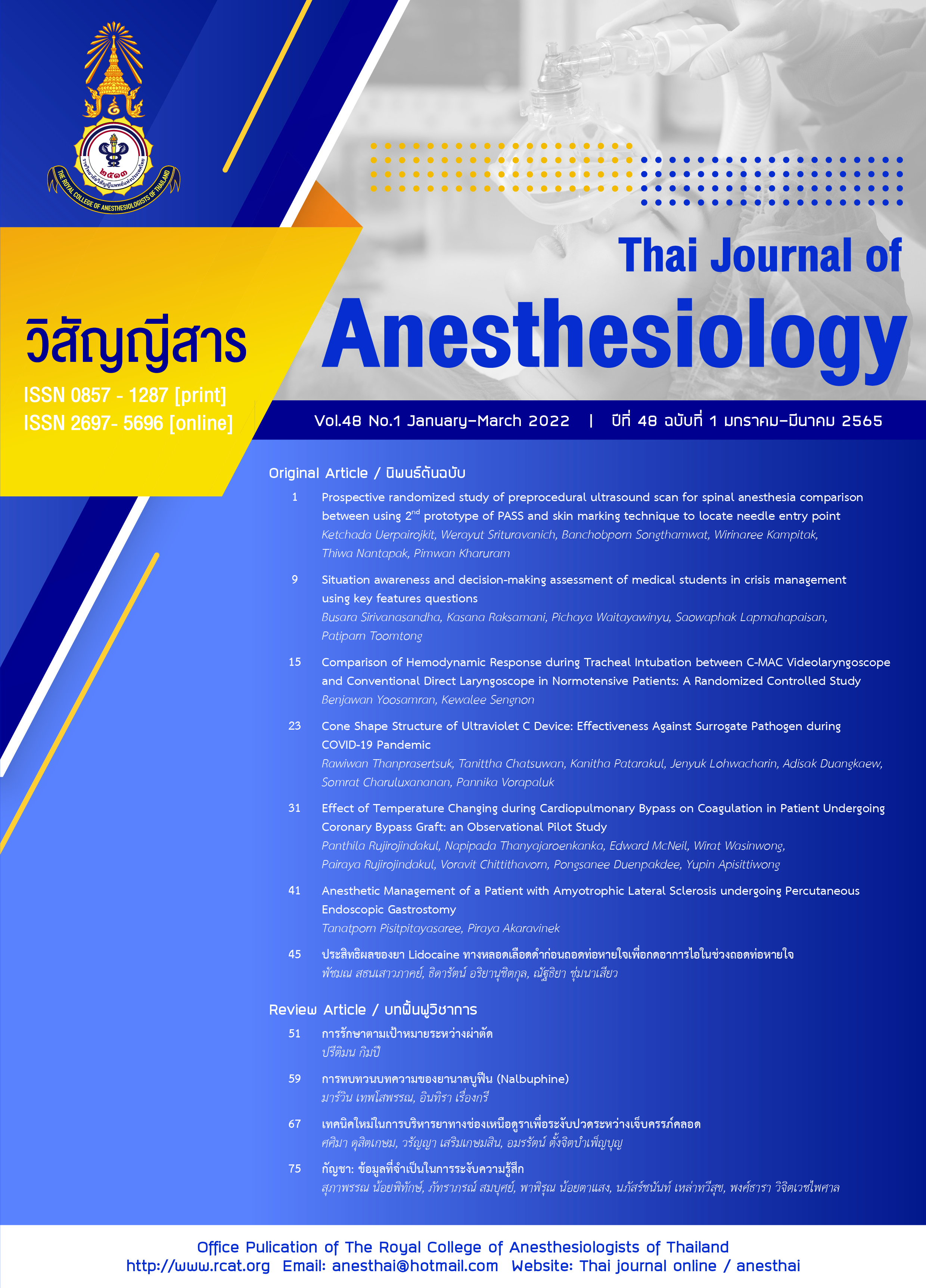Cannabis: Essential Information in Anesthesia
Main Article Content
Abstract
Cannabis, a cannabinoids substance, is transformed by cytochrome P-450 enzyme to lipophilic metabolites, tetrahydrocannabinol and cannabidiol, which binding with numerous receptors in the Endocannabinoid system. Drug administration via inhalation route is suitable to relieve acute illness since it can increase plasma concentration abruptly and effectively in 15-30 min. Oral route, however, is sometimes inefficient as absorption is irregular. The onset of action is 30-90 min and should last for 4-12 hr. It is apposite for chronic, long-term applications. Drug acts by stimulation and followed by depression. It affects brain and central nervous system causing cognitive dysfunction and psychosis, irritates bronchial airway inducing chronic cough, stimulates sympathetic nervous system initiating increased cardiac oxygen consumption and cerebral vasoconstriction. Subsequently, body hypothermia, immune system deficiency and simply prone to infections are commonly seen. Anesthesia personnel have to handle cannabis patients as good as ones with alcoholism or drug addiction. During perioperative anesthetic management, it is necessary to beware of drug interaction, volume, duration and route of consumption, last concentration and dosage, severe symptoms of nausea and vomiting as well as airway hypersensitivity and shivering. In addition, cannabis has synergistic effects on induction agents, sedatives, hypnotics, analgesics and muscle relaxants but antagonistic to the volatile agents.
Article Details

This work is licensed under a Creative Commons Attribution-NonCommercial-NoDerivatives 4.0 International License.
References
Skoglund G, Nockert M, Holst B. Viking and early Middle Ages Northern Scandinavian textiles proven to be made with hemp. Sci Rep. 2013;3:2686.
Yoanna MD. What makes the manufacture of hash oil so dangerous [internet]. 2014 [cited 2021 Jan 09]. Available from: https://www.cpr.org/news/story/what- makes-the-manufacture-of-hash-oil-so-dangerous.
Aggarwal SK, Carter GT, Sullivan MD, ZumBrunnen C, Morrill R, Mayer JD. Medicinal use of cannabis in the United States: historical perspectives, current trends, and future directions. J Opioid Manag. 2009;5:153-68.
Baron EP. Comprehensive review of medicinal marijuana, cannabinoids, and therapeutic implications in medicine and headache: what a long strange trip it’s been. Headache. 2015;55:885-916.
Abrams D, Guzman M. Cannabis in cancer care. Clin Pharmacol Ther. 2015;97:575-86.
ผกาทิพย์ รื่นระเริงศักดิ์. บทความเผยแพร่ความรู้สู่ประชาชน. กัญชากับการรักษาโรค [อินเทอร์เน็ต]. [เข้าถึงเมื่อ 9 ม.ค. 2564]. เข้าถึงได้จาก: https://pharmacy.mahidol.ac.th/th/knowledge/article/453/กัญชา/
วนิดา รัตนสุมาวงศ์, รัศมน กัลยาณศิริ, พิชัย แสงชาญชัย. ทฤษฎีของพฤติกรรมเสพติดและข้อถกเถียงที่มีในปัจจุบัน. วารสารสมาคมจิตแพทย์แห่งประเทศไทย 2561;63:295-306.
Wikipidia. กัญชา [อินเทอร์เน็ต]. [เข้าถึงเมื่อ 9 ม.ค. 2564]. เข้าถึงได้จาก: https://th.wikipidia.org/wiki/กัญชา.
Dickerson SJ. Cannabis and its effect on anesthesia. AANA J. 1980;48:526-8.
Huestis MA. Human cannabinoid pharmacokinetics. Chem Biodivers. 2009;4:1770-804.
บทความการใช้กัญชาทางการแพทย์ (medical use of cannabis). กัญชาทางการแพทย์. ระบบกัญชาในร่างกาย (endocannabinoid system) [อินเทอร์เน็ต]. [เข้าถึงเมื่อ 9 ม.ค. 2564]. เข้าถึงได้จาก: https://www.กัญชาทางการแพทย์.com/2019/05/endocannabinoid-system-cb1-cb2.html.
Andre CM, Hausman JF, Guerriero G. Cannabis sativa: the plant of the thousand and molecules. Front Plant Sci. 2016;7:19.
Schrot RJ, Hubbard JR. Cannabinoids: medical implication. Ann Med. 2016;48:128-41.
Woodbridge M. ข้อมูลเบื้องต้นเกี่ยวกับกัญชาทางการแพทย์. หนังสือแนะนำการใช้กัญชาเพื่อบำบัดรักษาโรค. Bedrocan International 2562 Netherland. 1-60 [อินเทอร์เน็ต]. [เข้าถึงเมื่อ 9 ม.ค. 2564]. เข้าถึงได้จาก: https://mdresearch.kku.ac.th/files/cannabis/MedicainalCannabisBook_v4.pdf.
บทความด้านสุขภาพจิต. CBC และ THC ในพืชกัญชาคืออะไร? [อินเทอร์เน็ต]. [เข้าถึงเมื่อ 9 ม.ค. 2564]. เข้าถึงได้จาก: https://www.dmh.go.th/news/view.asp?id=2264.
การศึกษาวิจัยเกี่ยวกับการใช้กัญชาในการรักษาอาการและโรคต่างๆ [อินเทอร์เน็ต]. [เข้าถึงเมื่อ 9 ม.ค. 2564]. เข้าถึงได้จาก: https://www.sawasdeeclinic.com/cannabis-research-benefit.
Garcia C, Palomo-Garo C, Gomez-Galvez Y, Fernandez-Ruiz J. Cannabinoid-dopamine interactions in the physiology and physiopathology of the basal ganglia. Br J Pharmacol. 2016;173:2069-79.
Cao D, Srisuma S, Bronstein AC, Hoyte CO. Characterization of edible marijuana product exposures reported to United States poison centers. Clin Toxicol. 2016;54:840-6.
Tetrault JM, Crothers K, Moore BA, Mehra R, Concato J, Fiellin DA. Effect of marijuana smoking on pulmonary function and respiratory
complications: a systematic review. Arch Intern Med. 2007;167:221-8.
Ribeiro LI, Ind PW. Effect of cannabis smoking on lung function and respiratory symptoms: a structured literature review. Prim Care Respir Med. 2016;26:16071.
Volkow ND, Baler RD, Compton WM, Weiss SR. Adverse health effects of marijuana use. N Engl J Med. 2014;370:2219-27.
Joshi M, Joshi A, Bartter T. Marijuana and lung disease. Curr Opin Pulm Med. 2014;20:173-9.
Sidney S. Cardiovascular consequences of marijuana use. J Clin Pharmacol. 2002;42(S1):S63-S70.
Andrea Teitel, Gregory Bozimowski. A review of the pharmacology and anesthetic implications of cannabis. AANA J. 2020;88:237-44.
Echeverria-Villalobos M, Todeschini AB, Stoicea N, Fiorda-Diaza J, Weaver T, Bergese SD. Perioperative care of cannabis users: a comprehensive review of pharmacological and anesthetic consideration. J Clin Anesth. 2019;7:41-9.
Kumar RN, Chambers WA, Pertwee RG. Pharmacological actions and therapeutic uses of cannabis and cannabinoids. Anaesthesia. 2001;56:1059-68.
Nahtigal l, Blake A, Hand A, Florentinus-Mefailoski A, Hashemi H, Friedberg JN. The pharmacological properties of cannabis. J Pain Manag. 2016;9:481-91.
กัญชาทางการแพทย์. “ปลดล็อค...กัญชาทางการแพทย์เสรี”. ผลิตภัณฑ์กัญชาทางการแพทย์ [อินเทอร์เน็ต].[เข้าถึงเมื่อ 9 ม.ค. 2564]. เข้าถึงได้จาก: www.medcannabis.go.th/ผลิตภัณฑ์กัญชาทางการแพทย์/ยาสารสกัดกัญชา.
บทความการใช้กัญชาทางการแพทย์ (medical use of cannabis). กัญชาทางการแพทย์. การพัฒนารูปแบบการใช้ผลิตภัณฑ์ยาจากกัญชาในประทศไทย [อินเทอร์เน็ต]. [เข้าถึงเมื่อ 9 ม.ค. 2564]. เข้าถึงได้จาก: https://www.กัญชาทางการแพทย์.com/2019/04/cannabis-drug-
research-in-thailand.html.
Abrams D, Guzman M. Cannabis in cancer care. Clin Pharmacol Ther. 2015;97:575-86.
Brandenburg D, Wernick R. Intravenous marijuana syndrome. West J Med. 1986;145:94-6.
The doctor will CBD you now: could CBD injections be the future? [internet]. [Cited 2021 Jan 09]. Available from: https://www.luxurylifestylemag.co.uk/health-wellbeing/the-dortor-will-cbd-you-now-could-cbd-injections-be-the-future/.
Areesantichai C, Perngparn U. Trend of new addictive substances: hashish. Chula Med J. 2007;51:105-14.
Teitel A, Bozimowski G. A review of the pharmacology and anesthetic implications of cannabis. AANA J. 2020;88:237-44.
บทความการใช้กัญชาทางการแพทย์ (medical use of cannabis). กัญชาทางการแพทย์. 33 ประเทศที่อนุญาตให้มีการใช้กัญชาทางการแพทย์ ประเทศไหนเสพกัญชาได้ไม่ผิดกฎหมาย [อินเทอร์เน็ต]. [เข้าถึงเมื่อ 9 ม.ค. 2564]. เข้าถึงได้จาก: https://www.กัญชาทางการแพทย์.com/2019/04/legality-of-cannabis-for-medical-and-recreational.html.
ประโยชน์และโทษที่อาจเกิดขึ้นจากการใช้กัญชาในทางการแพทย์และการเปิดเสรีการใช้กัญชา. วารสารวิจัยระบบสาธารณสุข. 2561;12:71-94.
กระทรวงสาธารณสุข. ประกาศกระทรวงสาธารณสุข เรื่อง ระบุชื่อยาเสพติดให้โทษในประเภท 5 พ.ศ. 2563 [อินเทอร์เน็ต]. [เข้าถึงเมื่อ 21 ต.ค. 2564]. เข้าถึงได้จาก: http://www.ratchakitcha.soc.go.th/DATA/PDF/2563/E/290/T_0033.PDF.
คณะอนุกรรมการพิจารณาข้อมูลเกี่ยวกับการใช้กัญชาทางการแพทย์. คำแนะนำสำหรับแพทย์ การใช้กัญชาทางการแพทย์. ฉบับที่ 1 ตุลาคม 2562 [อินเทอร์เน็ต]. [เข้าถึงเมื่อ 21 ต.ค. 2564]. เข้าถึงได้จาก: https://tmc.or.th/pdf/fact/guideline_cannabis_101062.pdf.
Schrot RJ, Hubbard JR. Cannabinoids: medical implication. Ann Med. 2016;48:128-41.
Huestis MA. Human cannabinoid pharmacokinetics. Chem Biodivers 2009;4:1770-804.
Frizza J, Chesher G, Jackson D, Malor R, Starmer G. The effect of delta 9, cannabidiol and cannabinol on the anaesthesia induced by various anaesthetic agents in mice. Psychopharmacol. 1977;55:103-7.
del Carmen Garcia M, Adler-Graschinsky E, Celuch SM. Hypotensive effect of anandamide through the activation of CB1 and VR1 spinal receptors in urethane-anesthetized rats. Naunyn Schmiedebergs Arch Pharmacol. 2003;368:270-6.
Georg R, Gotz B, Arlt F, Heymann CV. Cannabis consumption before surgery may be associated with increased tolerance of anesthetic drugs: a case report. Int j Case Rep Images. 2015;6:436-9.
Ibera C, Shalom B, Saifi F, Shruder J, Davidson E. Effects of cannabis extract premedication on anesthetic depth. Harefuah. 2018;157:162-6.
Johnson M, Melvin L, Althuis T, et al. Selective and potent analgesics derived from cannabinoids. J Clin Pharmacol. 1981;21(S1):S271-82.
Diana L, Cichewicz. Synergistic interactions between cannabinoid and opioid analgesics.
Life Sci. 2004;77:1317-24.


